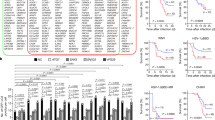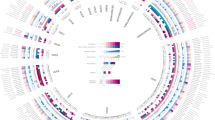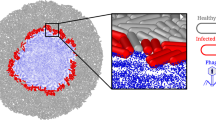Abstract
The last common metazoan ancestor (LCMA) emerged over half a billion years ago. These complex metazoans provided newly available niche space for viruses and microbes. Modern day contemporaries, such as cnidarians, suggest that the LCMA consisted of two cell layers: a basal endoderm and a mucus-secreting ectoderm, which formed a surface mucus layer (SML). Here we propose a model for the origin of metazoan immunity based on external and internal microbial selection mechanisms. In this model, the SML concentrated bacteria and their associated viruses (phage) through physical dynamics (that is, the slower flow fields near a diffusive boundary layer), which selected for mucin-binding capabilities. The concentration of phage within the SML provided the LCMA with an external microbial selective described by the bacteriophage adherence to mucus (BAM) model. In the BAM model, phage adhere to mucus protecting the metazoan host against invading, potentially pathogenic bacteria. The same fluid dynamics that concentrated phage and bacteria in the SML also concentrated eukaryotic viruses. As eukaryotic viruses competed for host intracellular niche space, those viruses that provided the LCMA with immune protection were maintained. If a resident virus became pathogenic or if a non-beneficial infection occurred, we propose that tumor necrosis factor (TNF)-mediated programmed cell death, as well as other apoptosis mechanisms, were utilized to remove virally infected cells. The ubiquity of the mucosal environment across metazoan phyla suggest that both BAM and TNF-induced apoptosis emerged during the Precambrian era and continue to drive the evolution of metazoan immunity.
Similar content being viewed by others
Log in or create a free account to read this content
Gain free access to this article, as well as selected content from this journal and more on nature.com
or
References
Abedon ST . (2015). Bacteriophage secondary infection. Virol Sin 30: 3–10.
Aggarwal BB . (2003). Signalling pathways of the TNF superfamily: a double-edged sword. Nat Rev Immunol 3: 745–756.
Aravind L, Dixit VM, Koonin EV . (2001). Apoptotic molecular machinery: vastly increased complexity in vertebrates revealed by genome comparisons. Science 291: 1279–1284.
Bäckhed F, Ley RE, Sonnenburg JL, Peterson Da, Gordon JI . (2005). Host-bacterial mutualism in the human intestine. Science 307: 1915–1920.
Bansil R, Stanley E, LaMont JT . (1995). Mucin biophysics. Annu Rev Physiol 57: 635–657.
Barber GN . (2001). Host defense, viruses and apoptosis. Cell Death Differ 8: 113–126.
Barr JJ, Auro R, Furlan M, Whiteson KL, Erb ML, Pogliano J et al. (2013). Bacteriophage adhering to mucus provide a non-host-derived immunity. Proc Natl Acad Sci USA 110: 10771–10776.
Barr JJ, Auro R, Sam-Soon N, Kassegne S, Peters G, Bonilla N et al. (2015). Subdiffusive motion of bacteriophage in mucosal surfaces increases the frequency of bacterial encounters. Proc Natl Acad Sci 112: 13675–13680.
Barton ES, White DW, Cathelyn JS, Brett-McClellan Ka, Engle M, Diamond MS et al. (2007). Herpesvirus latency confers symbiotic protection from bacterial infection. Nature 447: 326–329.
Berg CP, Engels IH, Rothbart A, Lauber K, Renz A, Schlosser SF et al. (2001). Human mature red blood cells express caspase-3 and caspase-8, but are devoid of mitochondrial regulators of apoptosis. Cell Death Differ 8: 1197–1206.
Bidle KD, Haramaty L, Barcelos E, Ramos J, Falkowski P . (2007). Viral activation and recruitment of metacaspases in the unicellular coccolithophore, Emiliania huxleyi. Proc Natl Acad Sci USA 104: 6049–6054.
Bond MR, Ghosh SK, Wang P, Hanover JA . (2014). Conserved nutrient sensor O-GlcNAc transferase is integral to C. elegans pathogen-specific immunity. PLoS One 9: e113231.
Bordenstein SR, Theis KR . (2015). Host biology in light of the microbiome: ten principles of holobionts and hologenomes. PLoS Biol 13: e1002226.
Bosch TCG . (2009). Hydra and the evolution of stem cells. Bioessays 31: 478–486.
Bossi L, Fuentes JA, Mora G, Figueroa-Bossi N . (2003). Prophage contribution to bacterial population dynamics. J Bacteriol 185: 6467–6471.
Bratosin D, Estaquier J, Petit F, Arnoult D, Quatannens B, Tissier JP et al. (2001). Programmed cell death in mature erythrocytes: a model for investigating death effector pathways operating in the absence of mitochondria. Cell Death Differ 8: 1143–1156.
Brogden KA . (2005). Antimicrobial peptides: pore formers or metabolic inhibitors in bacteria? Nat Rev Microbiol 3: 238–250.
Brown BE, Bythell JC . (2005). Perspectives on mucus secretion in reef corals. Mar Ecol Prog Ser 296: 291–309.
Brüssow H, Canchaya C, Hardt W-D . (2004). Phages and the evolution of bacterial pathogens: from genomic rearrangements to lysogenic conversion. Microbiol Mol Biol Rev 68: 560–602 table of contents.
Casadevall A, Pirofski LA . (2014). Ditch the term pathogen. Nature 516: 165–166.
Cash HL, Hooper LV . (2005). Commensal bacteria shape intestinal immune system development. ASM News 71: 77–83.
Chuong EB, Elde NC, Feschotte C . (2016). Regulatory evolution of innate immunity through co-option of endogenous retroviruses. Science 351: 1083–1087.
Closek CJ, Sunagawa S, DeSalvo MK, Piceno YM, DeSantis TZ, Brodie EL et al. (2014). Coral transcriptome and bacterial community profiles reveal distinct Yellow Band Disease states in Orbicella faveolata. ISME J 8: 2411–2422.
Corfield AP . (2013). Mucins: a biologically relevant glycan barrier in mucosal protection. Biochim Biophys Acta 1850: 236–252.
Davidson EH, Erwin DH . (2009). An integrated view of precambrian eumetazoan evolution. Cold Spring Harb Symp Quant Biol 74: 65–80.
Derrien M, van Passel MW, van de Bovenkamp JH, Schipper RG, de Vos WM, Dekker J . (2010). Mucin-bacterial interactions in the human oral cavity and digestive tract. Gut Microbes 1: 254–268.
Ellis HM, Horvitz HR . (1986). Genetic control of programmed cell death in the nematode C. elegans. Cell 44: 817–829.
Faure M, Moennoz D, Montigon F, Fay LB, Breulille D, Finot PA et al. (2002). Development of a rapid and convenient method to purify mucins and determine their in vivo synthesis rate in rats. Anal Biochem 307: 244–251.
Ferez-Vilar J, Hill RL . (1999). The structure and assembly of secreted mucins. J Biol Chem 274: 31751–31754.
Fogg PCM, Allison HE, Saunders JR, McCarthy AJ . (2010). Bacteriophage lambda: a paradigm revisited. J Virol 84: 6876–6879.
Fraser JS, Yu Z, Maxwell KL, Davidson AR . (2006). Ig-like domains on bacteriophages: a tale of promiscuity and deceit. J Mol Biol 359: 496–507.
Gendler SJ, Spicer AP . (1995). Epithelial mucin genes. Annu Rev Physiol 57: 607–634.
Grasis JA, Lachnit T, Anton-Erxleben F, Lim YW, Schmieder R, Fraune S et al. (2014). Species-specific viromes in the ancestral holobiont hydra. PLoS One 9: e109952.
Grow EJ, Flynn RA, Chavez SL, Bayless NL, Wossidlo M, Wesche DJ et al. (2015). Intrinsic retroviral reactivation in human preimplantation embryos and pluripotent cells. Nature 522: 221–225.
Hang HC, Bertozzi CR . (2005). The chemistry and biology of mucin-type O-linked glycosylation. Bioorganic Med Chem 13: 5021–5034.
Hanisch FG . (2001). O-glycosylation of the mucin type. Biol Chem 382: 143–149.
Hibbing ME, Fuqua C, Parsek MR, Peterson SB . (2010). Bacterial competition: surviving and thriving in the microbial jungle. Nat Rev Microbiol 8: 15–25.
Hill DB, Vasquez PA, Mellnik J, McKinley SA, Vose A, Mu F et al. (2014). A biophysical basis for mucus solids concentration as a candidate biomarker for airways disease. PLoS One 9: e87681.
Holler N, Zaru R, Micheau O, Thome M, Attinger A, Valitutti S et al. (2000). Fas triggers an alternative, caspase-8-independent cell death pathway using the kinase RIP as effector molecule. Nat Immunol 1: 489–495.
Johansson MEV, Sjövall H, Hansson GC . (2013). The gastrointestinal mucus system in health and disease. Nat Rev Gastroenterol Hepatol 10: 352–361.
Julenius K, Mølgaard A, Gupta R, Brunak S . (2005). Prediction, conservation analysis, and structural characterization of mammalian mucin-type O-glycosylation sites. Glycobiology 15: 153–164.
Kawai T, Akira S . (2010). The role of pattern-recognition receptors in innate immunity: update on Toll-like receptors. Nat Immunol 11: 373–384.
Lang T, Hansson GC, Samuelsson T . (2007). Gel-forming mucins appeared early in metazoan evolution. Proc Natl Acad Sci USA 104: 16209–16214.
Lasi M, David C, Böttger A . (2010). Apoptosis in pre-Bilaterians: hydra as a model. Apoptosis 15: 269–278.
Lewis K . (2000). Programmed death in bacteria. Microbiol Mol Biol Rev 64: 503–514.
Lozupone CA, Stombaugh JI, Gordon JI, Jansson JK, Knight R . (2012). Diversity, stability and resilience of the human gut microbiota. Nature 489: 220–230.
Lu W, Chen Q, Ying S, Xia X, Yu Z, Lui Y et al. (2016). Evolutionarily conserved primary TNF sequences relate to its primitive functions in cell death induction. J Cell Sci 129: 108–120.
MacKenzie DA, Jeffers F, Parker ML, Vibert-Vallet A, Bongaerts RJ, Roos S et al. (2010). Strain-specific diversity of mucus-binding proteins in the adhesion and aggregation properties of Lactobacillus reuteri. Microbiology 156: 3368–3378.
Minot S, Grunberg S, Wu GD, Lewis JD, Bushman FD . (2012). Hypervariable loci in the human gut virome. Proc Natl Acad Sci 109: 3962–3966.
Moya A, Sakamaki K, Mason BM, Huisman L, Forêt S, Weiss Y et al. (2016). Functional conservation of the apoptotic machinery from coral to man: the diverse and complex Bcl-2 and caspase repertoires of Acropora millepora. BMC Genomics 17: 1–20.
Müller WEG . (2003). The origin of metazoan complexity: porifera as integrated animals. Integr Comp Biol 43: 3–10.
Obeng N, Pratama AA, van Elsas J . (2016). The significance of mutualistic phages for bacterial ecology and evolution. Trends Microbiol 24: 440–449.
De Paepe M, Tournier L, Moncaut E, Son O, Langella P, Petit MA . (2016). Carriage of λ latent virus is costly for its bacterial host due to frequent reactivation in monoxenic mouse intestine. PLoS Genet 12: e1005861.
Quistad SD, Stotland A, Barott KL, Smurthwaite CA, Hilton BJ, Grasis JA et al. (2014). Evolution of TNF-induced apoptosis reveals 550 My of functional conservation. Proc Natl Acad Sci 111: 9567–9572.
Quistad SD, Traylor-Knowles N . (2016). Precambrian origins of the TNFR superfamily. Cell Death Discov 2: 16058.
Raff MC . (1992). Social controls on cell survival and cell death. Nature 356: 397–400.
Roberts GP . (1976). The role of disulfide bonds in maintaining the gel structure of bronchial mucus. Arch Biochem Biophys 173: 528–537.
Rodriguez-Brito B, Li L, Wegley L, Furlan M, Angly F, Breitbart M et al. (2010). Viral and microbial community dynamics in four aquatic environments. ISME J 4: 739–751.
Sakamaki K, Shimizu K, Iwata H, Imai K, Satou Y, Funayama N et al. (2014). The apoptotic initiator caspase-8: its functional ubiquity and genetic diversity during animal evolution. Mol Biol Evol 31: 3282–3301.
Schluter J, Foster KR . (2012). The evolution of mutualism in gut microbiota via host epithelial selection. PLoS Biol 10: e1001424.
Silberberg A, Meyer FA . (1982). Structure and function of mucus. Adv Exp Med Biol 144: 53–74.
Silveira CB, Rohwer FL . (2016). Piggyback-the-Winner in host-associated microbial communities. NPJ Biofilms Microbiomes 2: 16010.
Soller A, Epstein HT . (1965). Biochemical and immunological aspects of the exclusion of lambda by superinfection with T4. Virology 26: 715–726.
Steiner I . (1996). Human herpes viruses latent infection in the nervous system. Immunol Rev 152: 157–173.
Steller H . (1995). Mechanisms and genes of cellular suicide. Science 267: 1445–1449.
Stocker R, Seymour JR . (2012). Ecology and physics of bacterial chemotaxis in the ocean. Microbiol Mol Biol Rev 76: 792–812.
Sun J, Chang EB . (2014). Exploring gut microbes in human health and disease: pushing the envelope. Genes Dis 1: 132–139.
Tanji T, Ip YT . (2005). Regulators of the Toll and Imd pathways in the Drosophila innate immune response. Trends Immunol 26: 193–198.
Thompson JR, Rivera HE, Closek CJ, Medina M . (2015). Microbes in the coral holobiont: partners through evolution, development, and ecological interactions. Front Cell Infect Microbiol 4: 176.
Tscherne DM, Evans MJ, von Hahn T, Jones CT, Stamataki Z, McKeating JA et al. (2007). Superinfection exclusion in cells infected with hepatitis C virus. J Virol 81: 3693–3703.
Tsuboi S, Fukuda M . (2001). Roles of O-linked oligosaccharides in immune responses. BioEssays 23: 46–53.
Vega Thurber RL, Barott KL, Hall D, Liu H, Rodriguez-Mueller B, Desnues C et al. (2008). Metagenomic analysis indicates that stressors induce production of herpes-like viruses in the coral Porites compressa. Proc Natl Acad Sci USA 105: 18413–18418.
Villarreal LP . (2011). Viral ancestors of antiviral systems. Viruses 3: 1933–1958.
West BW, Scott JR . (1977). Superinfection immunity and prophage repression in phage P1 and P7 III. Induction by virulent mutants. Virology 78: 267–276.
Wild C, Huettel M, Klueter A, Kremb SG, Rasheed MYM, Jørgensen BB . (2004). Coral mucus functions as an energy carrier and particle trap in the reef ecosystem. Nature 428: 66–70.
Yang X, Forier K, Steukers L, van Vlierberghe S, Dubruel P, Braeckmans K et al. (2012). Immobilization of pseudorabies virus in porcine tracheal respiratory mucus revealed by single particle tracking. PLoS One 7: e51054.
Zou G, Zhang B, Lim P-Y, Yuan Z, Bernard Ka, Shi P-Y . (2009). Exclusion of West Nile virus superinfection through RNA replication. J Virol 83: 11765–11776.
Sakamaki K, Imai K, Tomii K, Miller D . (2015). Evolutionary analyses of caspase-8 and its paralogs: deep origins of the apoptotic signaling pathways. Bioessays 37: 767–776.
Author information
Authors and Affiliations
Corresponding author
Ethics declarations
Competing interests
The authors declare no conflict of interest.
Rights and permissions
About this article
Cite this article
Quistad, S., Grasis, J., Barr, J. et al. Viruses and the origin of microbiome selection and immunity. ISME J 11, 835–840 (2017). https://doi.org/10.1038/ismej.2016.182
Received:
Revised:
Accepted:
Published:
Issue date:
DOI: https://doi.org/10.1038/ismej.2016.182
This article is cited by
-
Thermal stress triggers productive viral infection of a key coral reef symbiont
The ISME Journal (2022)
-
Implications of oral streptococcal bacteriophages in autism spectrum disorder
npj Biofilms and Microbiomes (2022)
-
Diversity patterns of bacteriophages infecting Aggregatibacter and Haemophilus species across clades and niches
The ISME Journal (2019)



